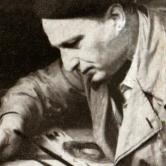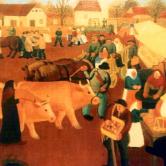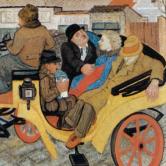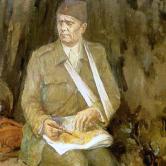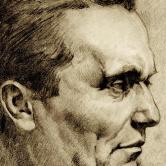Personage > Marijan Detoni
Marijan Detoni was a student at Zagreb Academy of Fine Arts from 1924 to 1928, together with Ljubo Babić, a famous Croatian painter, and took graphics class with professor T. Križman. From 1928 to 1929 he took some specialist courses at V. Bečić’s class. He was a member of a group of artists called Zemlja (Earth) with whom he had some exhibitions from 1931 to 1934. He took some additional painting courses in Paris (in 1933). He worked as a teacher in Vukovar (1933-1936), and Karlovac (1936-1942). In 1942 he joined the communist Partisan Resistance Movement, painting the images related to it, and writing about it in his diary. He was a professor at Zagreb Academy of Fine Arts (1945-1975), the head of Graphics Department and a member of the Yugoslav Academy of Science and Arts.The line of the artistic Detoni family didn’t end with Marijan. His son Dubravko followed in father's footsteps, becoming a prominent modern style pianist and a composer. Dubravko’s son Danijel also attended Music Academies, and often performed in Križevci.
In hi early works, Detoni turned his attention to spatial relationships (Self Portrait with a Palette, 1927, Girl, 1928.). He was influenced by Paul Cezanne (which is clearly visible in his Spring Saloon painting). His paintings from the later period (1929 to 1935) reflect social issues. Images of everyday life are presented with humour, and grotesque (Announcement, 1929), and he relies on elements such as color and space (Fair in Križevci, 1930). By painting the landscape in a more realist way (turning away from artism), using simple drawings and lines, he creates specific landscape paintings (Potočka street, 1930) characterized by large figures which are painted in only a few colors (Sleighs, 1932). His distinctive and highly graphic sensibility is displayed in his linocuts People from Seine, put together in 1934, which depict life of homeless people in Paris. However, the images on the ink drawings (A Cortege, 1932, Embarkment Point.the Danube River, 1933) don’t represent a harsh critique of society, and the painter retains a sense of humour. In 1935 he was in Vukovar, and some of his most famous paintings, like Wobbly Carriage and Feeding date from this period.
In the second period of his works (1936 - 1942) Marijan uses endless possibilities of color expression (Memories of Spain, 1936). He was a pioneer of abstract painting in Croatia, and in 1938 he made two avant-garde paintings: A Phantasy of a wrecked wall I and II). Upon his return from Paris (1939) he assumed a modernist style of painting (Riders, 1939), and he goes back to painting scenes from local life (Kalnik Symphony, 1939, Dnace, 1940). He painted radiant landscapes, using a vivid palette of saturated colors (A Landscape of Kupe, 1940), depicting scenes of work, the insides of factories, and everyday life (Factory, 1939). His Graphic Maps, in which tragical war events were transformed into a vision or hallucination, also date from this period (Daisies, Flowers of Fantasy (1941), Products of Excitement and Map U (1941 - 1942). In the period from 1942 to 1952 he made several paintings of war scenes (Crossing the Neretva River, 1946, Partisans Crossing the River in a Boat, 1947, and Night on Mount Zelengora, 1950). Following World War II (1952 - 1980) he began to paint in the Expressionist style (Self-portrait with a Handle, 1952), treating a broad range of subject, from war scenes (Under The Black Sun, 1960, Night In The Mountains, 1963) to poetical reminiscences (Playing with a Ball, 1956, Night Ceremony, 1957). He also painted illusionary and space landscapes merging disparate pieces of different visual and musical worlds (The Violin Concerto, 1955, Dramatic Symphony, 1966). He also took a step into abstract painting, using unusual composition and some associative elements (Panic, 1960, Birth of Fire, 1964, Flowers, 1969). He had solo exhibitions all over Croatia, Bosnia and Herzegovina, and Serbia.


